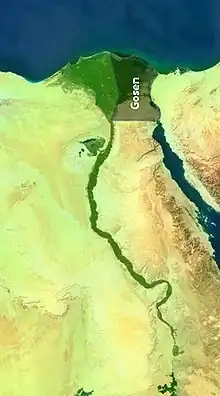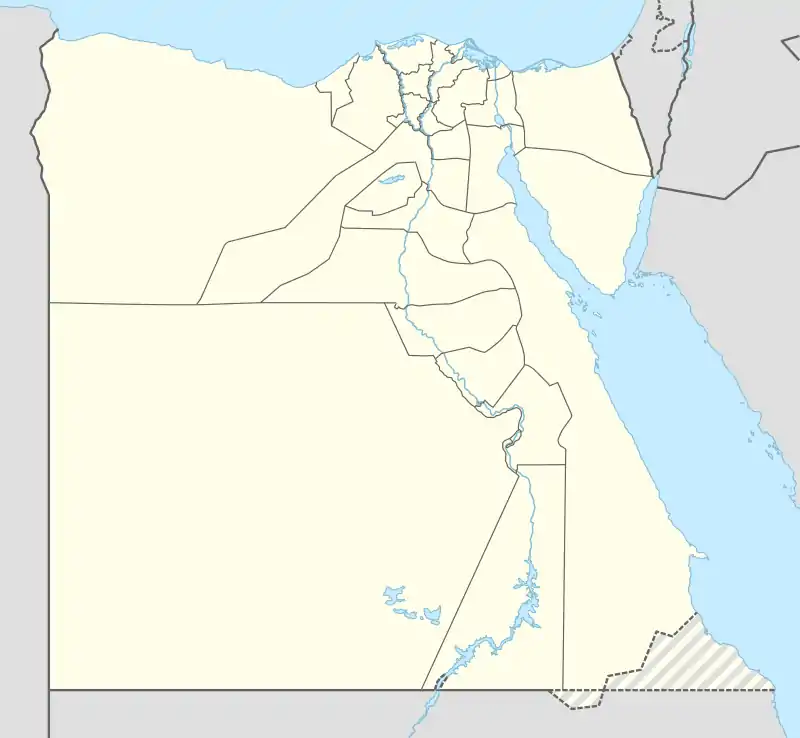30°52′20″N 31°28′39″E / 30.87222°N 31.47750°E

The land of Goshen (Hebrew: אֶרֶץ גֹּשֶׁן, ʾEreṣ Gōšen) is named in the Hebrew Bible as the place in Egypt given to the Hebrews by the pharaoh of Joseph (Book of Genesis, Genesis 45:9–10), and the land from which they later left Egypt at the time of the Exodus. It is believed to have been located in the eastern Nile Delta, lower Egypt; perhaps at or near Avaris, the seat of power of the Hyksos kings.
Biblical text
The land of Goshen is mentioned in the biblical books of Genesis and Exodus. In the story of Joseph, which comprises the final chapters of Genesis, the patriarch Jacob is facing famine and sends ten of his sons to Egypt to buy grain.[1] Joseph, another of Jacob's sons, is a high official in Egypt and allows his father and brothers to settle in Egypt.[2] In Genesis 45:10, Goshen is treated as being close to Joseph, who lives at the pharaoh's court[3] and in Genesis 47:5 Goshen is called "the best part" of the land of Egypt.[4] But it is also implied to be somewhat set apart from the rest of Egypt,[5] because Joseph tells his family to present themselves to the pharaoh as keepers of livestock, "in order that you may settle in the land of Goshen, because all shepherds are abhorrent to the Egyptians."[6] Genesis 47:11 interchanges the "land of Rameses" with Goshen: "Joseph settled his father and his brothers and granted them a holding in the land of Egypt, in the best part of the land, in the land of Rameses, as Pharaoh had instructed."[7]
In Exodus, Jacob's descendants, the Israelites, continue to live in Egypt and grow numerous.[8] The name of Goshen appears only twice in Exodus, in the narration of the Plagues of Egypt, in which Goshen as the dwelling place of the Israelites is spared the plague of flies and plague of hail that afflict the Egyptians.[9]
Etymology
If the Septuagint reading "Gesem" is correct, the word, which in its Hebrew form has no known meaning, may mean "cultivated"—comparing the Arabic root j-š-m, "to labor". Some Egyptologists have suggested a connection with the name gsm used in reference to a lake in Papyrus Anastasi IV, as the name appears to have been used as a toponym in the Wādī Ṭumīlāt.[10] Because Goshen was apparently the same region, called by the Greeks the "Arabian nome," which had its capital at Phakousa. The name represented the Egyptian Pa-qas (Brugsch, Geog., I, 298), the name of a town, with the determinative for "pouring forth".[11] Donald Redford, while not disputing the location of Goshen, gives a different origin for the name, deriving it from "Gasmu," the rulers of the Bedouin Qedarites who occupied the eastern Delta from the 7th century BCE, but John Van Seters thinks this unlikely.[12]
Identification

In 1885, Édouard Naville identified Goshen as the 20th nome of Egypt, located in the eastern Delta, and known as "Gesem" or "Kesem" during the Twenty-sixth dynasty of Egypt (672–525 BCE). It covered the western end of the Wadi Tumilat, the eastern end being the district of Succoth, which had Pithom as its main town, extended north as far as the ruins of Pi-Ramesses (the "land of Rameses"), and included both crop land and grazing land.[12]
The scholars Isaac Rabinowitz, Israel Ephʿal, Jan Retsö, and David F. Graf identify the land of Goshen with the parts of the Qedarite kingdom of "Arabia" located to the east of the Nile Delta and around Pithom, and which became known to ancient Egyptians as Gsm (𓎤𓊃𓅓𓏏𓊖)[12] and to Jews as the ʾEreṣ Gōšen (אֶרֶץ גֹּשֶׁן), that is the lit. 'Land of Gešem',[13] after either the Qedarite king Gešem[14][15] or after his dynasty.[15]
Although the scholar John Van Seters has opposed the identification of ʾEreṣ Gōšen with the Qedarite territories in eastern Egypt based on claims that the Qedarites never ruled the region of the Wādī Ṭumīlāt,[12] the discovery in the Wādī Ṭumīlāt region of Qedarite remains, such as a shrine to the goddess al-Lāt, makes Van Seters's opposition to this identification untenable.[16][15][17][13]
Notes
- ↑ Genesis 42
- ↑ Genesis 45
- ↑ Bietak 2015, p. 26.
- ↑ Genesis 47:5
- ↑ Van Seters 2004, p. 384.
- ↑ Genesis 46:34
- ↑ Genesis 47:11
- ↑ Exodus 1:7
- ↑ Grabbe 2014, p. 43.
- ↑ Bietak 2015, p. 22.
- ↑ "www.Bibler.org - Dictionary - Goshen". 2012-10-08.
- 1 2 3 4 Van Seters 2001, pp. 267–269.
- 1 2 Retsö 2013, pp. 300–301.
- ↑ Retsö 2013, pp. 250–251.
- 1 2 3 Ephʿal 1984, pp. 210–214.
- ↑ Rabinowitz 1956.
- ↑ Graf 1997, p. 223.
References
- Bietak, Manfred (2015). "On the Historicity of the Exodus: What Egyptology Today Can Contribute to Assessing the Biblical Account of the Sojourn in Egypt". In Levy, Thomas E.; Schneider, Thomas; Propp, William H. C. (eds.). Israel's Exodus in Transdisciplinary Perspective: Text, Archaeology, Culture, and Geoscience. Springer. ISBN 978-3-319-04767-6.
- Ephʿal, Israel (1984). The Ancient Arabs: Nomads on the Borders of the Fertile Crescent, 9th-5th Centuries B.C. Jerusalem: Magnes Press. ISBN 978-0-685-74243-3.
- Grabbe, Lester (2014). "Exodus and History". In Dozeman, Thomas B.; Evans, Craig A.; Lohr, Joel N. (eds.). The Book of Exodus: Composition, Reception, and Interpretation. Brill. ISBN 978-90-04-28266-7.
- Graf, David F. (1997). "Palestine: Palestine in the Persian through Roman Periods". In Meyers, Eric M.; Dever, William G.; Meyers, Carol L.; Muhly, James D.; Pardee, Dennis; Sauer, James A.; Finney, Paul Corby; Jorgensen, John S. (eds.). The Oxford Encyclopedia of Archaeology in the Near East. Vol. 4. Oxford, United Kingdom; New York City, United States: Oxford University Press. pp. 222–228. ISBN 978-0-195-06512-1.
- Rabinowitz, Isaac (1956). "Aramaic Inscriptions of the Fifth Century B. C. E. from a North-Arab Shrine in Egypt". Journal of Near Eastern Studies. Chicago, United States: University of Chicago Press. 15 (1): 1–9. doi:10.1086/371302. JSTOR 542658. S2CID 161559065. Retrieved 1 January 2023.
- Retsö, Jan (2013). The Arabs in Antiquity: Their History from the Assyrians to the Umayyads. London, United Kingdom; New York City, United States: Routledge. ISBN 978-1-136-87289-1.
- Van Seters, John (2001). "The Geography of the Exodus". In Dearman, J. Andrew; Graham, M. Patrick (eds.). The Land that I Will Show You: Essays on the History and Archaeology of the Ancient Near East in Honor of J. Maxwell Miller. Journal for the Study of the Old Testament: Supplement Series. Vol. 343. Sheffield, United Kingdom: Sheffield Academic Press. pp. 255–276. ISBN 978-0-567-35580-5.
- Van Seters, John (2004). "The Joseph Story: Some Basic Observations". In Knoppers, Gary N.; Hirsch, Antoine (eds.). Egypt, Israel, and the Ancient Mediterranean World: Studies in Honor of Donald B. Redford. Brill. ISBN 978-90-04-13844-5.